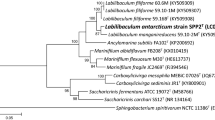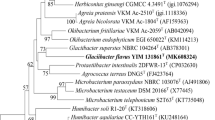Abstract
A Gram-negative, strictly aerobic, chemoorganotrophic, bacteriochlorophyll a-containing, slow-growing bacterium was isolated from the lichen Flavocetraria nivalis and designated strain BP6-180914 T. Cells of this strain were large nonmotile rods, which reproduced by binary fission. Cells grew under oxic conditions and were able to utilize sugars and several polysaccharides, including starch and pectin. Strain BP6-180914 T was psychrotolerant and moderately acidophilic growing at 4–35 °C (optimum 20–28 °C) and between pH 4.0 and 7.5 (optimum 4.5–5.5). The major fatty acids were C18:1ω7c, C19:0 cyclo, C16:0 and C18:0. The polar lipids were diphosphatidylglycerols, phosphatidylglycerols, phosphatidylethanolamines, phosphatidylcholines, unidentified aminolipids, and a number of glycolipids, the major one being an unidentified glycolipid. The quinone was Q-10. The DNA G + C content was 63.65%. Comparative 16S rRNA gene sequence analysis revealed that strain BP6-180914 T was a member of the order Hyphomicrobiales and belonged to the family Lichenihabitantaceae defined by the lichen-dwelling facultative aerobic chemo-organotroph Lichenihabitans psoromatis (92.7% sequence similarity). The results of phylogenomic and genomic relatedness analyses showed that strain BP6-180914 T could clearly be distinguished from other species in the order Hyphomicrobiales with average nucleotide identity values of < 74.05% and genome-to-genome distance values of < 21.1%. The AAI value of 65.9% between strain BP6-180914 T and L. psoromatis allowed us to assign this strain to the novel genus of the family Lichenihabitantaceae. Therefore, it is proposed that strain BP6-180914 T represents a novel species in a new genus, Lichenifustis flavocetrariae gen. nov., sp. nov.; strain BP6-180914 T (= KCTC 92872 T = VKM B-3641 T = UQM 41506 T) is the type strain.



Similar content being viewed by others
Data availability
The authors confirm that the data supporting the findings of this study are available within the article and its supplementary materials. 16S rRNA gene sequence and draft genome are available in National Center for Biotechnology Information.
References
Aziz RK, Bartels D, Best AA et al (2008) The RAST server: rapid annotations using subsystems technology. BMC Genomics 9:75. https://doi.org/10.1186/1471-2164-9-75
Bankevich A, Nurk S, Antipov D et al (2012) SPAdes: a new genome assembly algorithm and its applications to single-cell sequencing. J Comput Biol 19:455–477. https://doi.org/10.1089/cmb.2012.0021
Benning C, Huang ZH, Gage DA (1995) Accumulation of a novel glycolipid and a betaine lipid in cells of Rhodobacter sphaeroides grown under phosphate limitation. Arch Biochem Biophys 317(1):103–111. https://doi.org/10.1006/abbi.1995.1141
Bolger AM, Lohse M, Usadel B (2014) Trimmomatic: a flexible trimmer for Illumina sequence data. Bioinformatics 30:2114–2120. https://doi.org/10.1093/bioinformatics/btu170
Bowman JP (2015) Methylocystaceae fam. nov. In: Trujillo ME, Dedysh S, DeVos P, Hedlund B, Kämpfer P, Rainey FA, Whitman WB (eds) Bergey’s Manual of Systematics of Archaea and Bacteria. Wiley, Hoboken. https://doi.org/10.1002/9781118960608.fbm00169
Carvalho FM, Souza RC, Barcellos FG, Hungria M, Vasconcelos AT (2010) Genomic and evolutionary comparisons of diazotrophic and pathogenic bacteria of the order Rhizobiales. BMC Microbiol 8(10):37. https://doi.org/10.1186/1471-2180-10-37
Chaudhari NM, Gupta VK, Dutta C (2016) BPGA-an ultra-fast pan-genome analysis pipeline. Sci Rep 6:24373. https://doi.org/10.1038/srep24373
Chaumeil P-A, Mussig AJ, Hugenholtz P, Parks DH (2020) GTDB-Tk: a toolkit to classify genomes with the genome taxonomy database. Bioinformatics 36(6):1925–1927. https://doi.org/10.1093/bioinformatics/btz848
Cornelissen JHC, Lang SI, Soudzilovskaia NA, During HJ (2007) Comparative cryptogam ecology: a review of bryophyte and lichen traits that drive biogeochemistry. Ann Bot 99:987–1001. https://doi.org/10.1093/aob/mcm030
Dedysh SN, Dunfield PF (2016) Beijerinckiaceae. In: Trujillo ME, Dedysh S, DeVos P, Hedlund B, Kämpfer P, Rainey FA, Whitman WB (eds) Bergey’s Manual of Systematics of Archaea and Bacteria. Wiley, Hoboken
Edgar RC (2004) MUSCLE: multiple sequence alignment with high accuracy and high throughput. Nucleic Acid Res 32(5):1792–1797. https://doi.org/10.1093/nar/gkh340
Edgar RC (2010) Search and clustering orders of magnitude faster than BLAST. Bioinformatics 26(19):2460–2461. https://doi.org/10.1093/bioinformatics/btq461
Garrity GM, Bell JA, Lilburn T (2015) Methylobacteriaceae fam nov. In: Trujillo ME, Dedysh S, DeVos P, Hedlund B, Kämpfer P, Rainey FA, Whitman WB (eds) Bergey’s Manual of Systematics of Archaea and Bacteria. Wiley, Hoboken
Manual of Methods for General Bacteriology (1981). In:P Gerhardt, RGE Murray, RN Costilow, EW Nester, WA Wood, NR Krieg and GB Phillips, American Society for Microbiology, pp. 524.
Goris J, Konstantinidis KT, Klappenbach JA et al (2007) DNA-DNA hybridization values and their relationship to whole-genome sequence similarities. Int J Syst Evol Microbiol 57(Pt 1):81–91. https://doi.org/10.1099/ijs.0.64483-0
Hodkinson BP, Gottel NR, Schadt CW et al (2012) Photoautotrophic symbiont and geography are major factors affecting highly structured and diverse bacterial communities in the lichen microbiome. Environ Microbiol 4(1):147–161. https://doi.org/10.1111/j.1462-2920.2011.02560.x
Jones DT, Taylor WR, Thornton JM (1992) The rapid generation of mutation data matrices from protein sequences. Comput Appl Biosci 8:275–282. https://doi.org/10.1093/bioinformatics/8.3.275
Kates M (1972) Techniques of lipidology: Isolation, analysis and identification of lipids. In: Work TS, Work E (eds) Laboratory techniques in biochemistry and molecular Biology. Elsevier, Amsterdam
Klarenberg IJ, Keuschnig C, Warshan D et al (2020) The total and active bacterial community of the chlorolichen Cetraria islandica and its response to long-term warming in sub-Arctic tundra. Front Microbiol 11:540404. https://doi.org/10.3389/fmicb.2020.540404
Konstantinidis KT, Rosselló-Móra R, Amann R (2017) Uncultivated microbes in need of their own taxonomy. ISME J 11:2399–2406. https://doi.org/10.1038/ismej.2017.113
Kumar S, Stecher G, Li M et al (2018) MEGA X: molecular evolutionary genetics analysis across computing platforms. Mol Biol Evol 35(6):1547–1549. https://doi.org/10.1093/molbev/msy096
Kuykendall LD (2015) Rhizobiaceae. In: Trujillo ME, Dedysh S, DeVos P, Hedlund B, Kämpfer P, Rainey FA, Whitman WB (eds) Bergey’s Manual of Systematics of Archaea and Bacteria. Wiley, Hoboken
Lane DJ (1991) 16S/23S rRNA sequencing. In: Stackebrandt E, Goodfellow M (eds) Nucleic Acid Techniques in Bacterial Systematic. John Wiley, New York, pp 115–175
Meier-Kolthoff JP, Carbasse JS, Peinado-Olarte RL, Göker M (2022) TYGS and LPSN: a database tandem for fast and reliable genome-based classification and nomenclature of prokaryotes. Nucleic Acids Res 50(D1):D801–D807. https://doi.org/10.1093/nar/gkab902
Minnikin DE, O’Donnell AG, Goodfellow M et al (1984) An integrated procedure for the extraction of bacterial isoprenoid quinones and polar lipids. J Microbiol Methods 2(5):233–241. https://doi.org/10.1016/0167-7012(84)90018-6
Nash TH (2008) Lichen Biology, 2nd edn. Cambridge University Press, Cambridge, MA
Noh HJ, Baek K, Hwang CY et al (2019) Lichenihabitans psoromatis gen. nov., sp. Nov., a member of a novel lineage (Lichenihabitantaceae fam. nov.) within the order of Rhizobiales isolated from Antarctic lichen. Int J Syst Evol Microbiol 69(12):3837–3842. https://doi.org/10.1099/ijsem.0.003695
Noh HJ, Shin SC, Park Y et al (2020) Lichenicola cladoniae gen. nov., sp. nov., a member of the family Acetobacteraceae isolated from an Antarctic lichen. Int J Syst Evol Microbiol 70(11):5918–5925. https://doi.org/10.1099/ijsem.0.004495
Noh HJ, Park Y, Hong SG, Lee YM (2021) Diversity and physiological characteristics of Antarctic lichens-associated bacteria. Microorganisms 9(3):607. https://doi.org/10.3390/microorganisms9030607
Pankratov TA, Tindall BJ, Liesack W, Dedysh SN (2007) Mucilaginibacter paludis gen. nov., sp. nov. and Mucilaginibacter gracilis sp. nov., pectin-, xylan- and laminarin-degrading members of the family Sphingobacteriaceae from acidic Sphagnum peat bog. Int J Syst Evol Microbiol 57(10):2349–2354. https://doi.org/10.1099/ijs.0.65100-0
Pankratov TA, Grouzdev DS, Patutina EO et al (2020a) Lichenibacterium ramalinae gen. nov., sp, nov., Lichenibacterium minus sp. nov., the first endophytic beta-carotene producing bacterial representatives from lichen thalli and the proposal of the new family Lichenibacteriaceae within the order Rhizobiales. Anton Leeuw Int J g. 113(4):477–489. https://doi.org/10.1007/s10482-019-01357-6
Pankratov TA, Grouzdev DS, Patutina EO et al (2020b) Lichenicoccus roseus gen. nov., sp. nov., the first bacteriochlorophyll a-containing, psychrophilic and acidophilic Acetobacteraceae bacteriobiont of lichen Cladonia species. Int J Syst Evol Microbiol 70(8):4591–4601. https://doi.org/10.1099/ijsem.0.004318
Pankratov TA, Nikitin PA, Patutina EO (2022) Genome analysis of two lichen bacteriobionts, Lichenibacterium ramalinae and Lichenibacterium minus: toxin-antitoxin systems and secretion proteins. Microbiology 91:160–172. https://doi.org/10.1134/S0026261722020096
Park C, Kim K, Kim O, Jeong G, Hong S (2016) Bacterial communities in Antarctic lichens. Antarct Sci 28(6):455–461. https://doi.org/10.1017/S0954102016000286
Printzen Ch, Fernández-Mendoza F, Muggia L et al (2012) Alphaproteobacterial communities in geographically distant populations of the lichen Cetraria aculeata. FEMS Microbiol Ecol 82(2):316–325. https://doi.org/10.1111/j.1574-6941.2012.01358.x
Rodriguez-R LM, Konstantinidis KT (2014) Bypassing cultivation to identify bacterial species culture-independent genomic approaches identify credibly distinct clusters, avoid cultivation bias, and provide true insights into microbial species. Microbe 9(3):111–118
Rosselli R, La Porta N, Muresu R, Stevanato P, Concheri G, Squartini A (2021) Pangenomics of the symbiotic Rhizobiales. Core and accessory functions across a group endowed with high levels of genomic plasticity. Microorganisms. 9(2):407. https://doi.org/10.3390/microorganisms9020407
Sierra MA, Danko DC, Sandoval TA et al (2020) The microbiomes of seven lichen genera reveal host specificity, a reduced core community and potential as source of antimicrobials. Front Microbiol 11:398. https://doi.org/10.3389/fmicb.2020.00398
Tamura K, Nei M (1993) Estimation of the number of nucleotide substitutions in the control region of mitochondrial DNA in humans and chimpanzees. Mol Biol Evol 10:512–526. https://doi.org/10.1093/oxfordjournals.molbev.a040023
Tatusova T, Dicuccio M, Badretdin A et al (2016) NCBI prokaryotic genome annotation pipeline. Nucleic Acid Res 44:6614–6624. https://doi.org/10.1093/nar/gkw569
Vaskovsky VE, Kostetsky EY, Vasendin IM (1975) A universal reagent for phospholipid analysis. J Chromatogr 114(1):129–141
Acknowledgements
The authors thank Dr. Evgeny S. Korchikov (Samara National Research University) for taxonomic identification of the lichen Flavocetraria nivalis; Prof. (Emeritus) Aharon Oren (Hebrew University of Jerusalem) for help with Latin transcription in preparing the protologue; participants of the “Pallada” voyage Andrey A. Feshchuk, Sergey Yu. Romashin, and Lev A. Sergeev for their assistance in collecting lichen specimens.
Funding
The authors have not disclosed any funding.
Author information
Authors and Affiliations
Contributions
TP. designed the study. TP. examined lichen samples, obtained isolates, performed growth experiments; took phase contrast and micro pictures. YML. annotated and analyzed the genome sequences; OS. collected and prepared lichen specimens; ET. prepared ultrathin sections of cells and took pictures; AA. analyzed the composition of fatty acids and quinones; E.I. received data on the composition of lipids; T.P. and Y.M.L. wrote the manuscript.
Corresponding author
Ethics declarations
Conflict of interest
The authors declare that they have no conflict of interest.
Additional information
Communicated by Yusuf Akhter.
Publisher's Note
Springer Nature remains neutral with regard to jurisdictional claims in published maps and institutional affiliations.
Supplementary Information
Below is the link to the electronic supplementary material.
Rights and permissions
Springer Nature or its licensor (e.g. a society or other partner) holds exclusive rights to this article under a publishing agreement with the author(s) or other rightsholder(s); author self-archiving of the accepted manuscript version of this article is solely governed by the terms of such publishing agreement and applicable law.
About this article
Cite this article
Pankratov, T.A., Samylina, O.S., Tikhonova, E.N. et al. A novel bacteriobiont of the Arctic lichen Flavocetraria nivalis, Lichenifustis flavocetrariae gen. nov, sp. nov. demonstrating hydrolytic properties and containing a full set of the Calvin–Benson–Bassham cycle genes. Arch Microbiol 205, 232 (2023). https://doi.org/10.1007/s00203-023-03577-x
Received:
Revised:
Accepted:
Published:
DOI: https://doi.org/10.1007/s00203-023-03577-x




